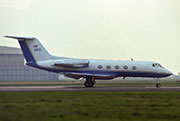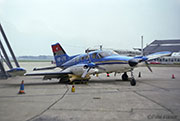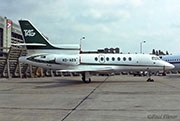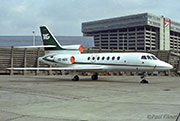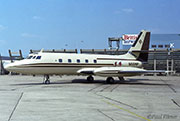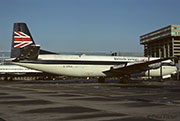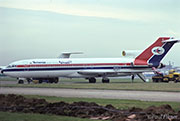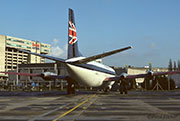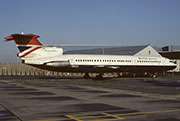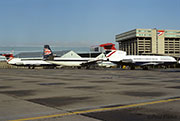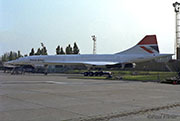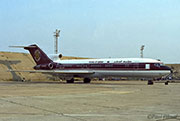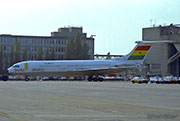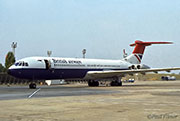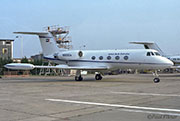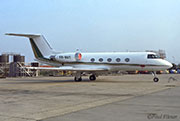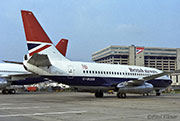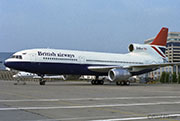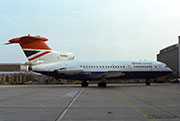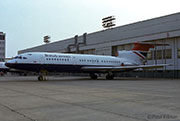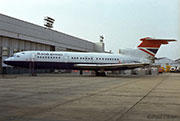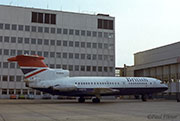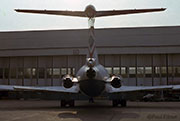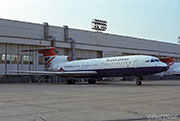SAS DC-9-41 SE-DDT was one of only four that operated in this bare-metal silver colour scheme, as an experiment to see if maintenance costs were lower. The last four delivered participated, and the scheme was short lived. This particular example ended up in a shopping mall in Sunrise, FL and then moved to Texas to be used as a house in 2012.
Jetstar 6 N66MP, should still be present at the South Seattle Community College, without tail and outer wings, and is used as a hydraulics trainer.
Cessna 421 HB-LFQ, suffered an undercarriage collapse on landing and was craned off the runway. It was parked by the Tristar blast screens for a long time , before departing for Switzerland on the back of a truck.
Falcon 50 HZ-A03, flown by TAG, was a regular visitor. This aircraft is still operational today with the French Navy as '7?, and is modified as a Falcon 50SURMAR
British Airways Cargo Vickers Vanguard Merchantman G-APEG, still in its hybrid BEA/BA colour scheme, was sold to Air Bridge Carriers after ending its service with BA, and eventually ended up as a fire trainer at EMZ. She was broken up in the late '90s.
Yemenia B727 4W-ACG was operating a flight on behalf of the North Yemen Government, carrying Prime Minister Abdul Aziz Gahni plus eight other passengers, for talks with the British Government. The aircraft was issued with a High Court writ and impounded while parked at the Royal Suite, due to non-payment to British Midland Airways for help in setting up the airline. She was later towed to close by the Pan Am hangars and blocked from moving with a lorry.
The aircraft was written-off on 1 August 2001, while registered as 7O-ACW, when it overran the runway at Asmara in Eritrea. 7O was the new prefix for Yemen aircraft.
Most photographers during this time took exactly the same shot. This was a very rare movement, and stayed parked for weeks.
British Airways Concorde G-BFKW was an airframe that was built but had no buyer. It was initially loaned to BA to cover for G-BOAC, which was being repaired by British Aerospace. After an intake ramp failure in April 1980 the aircraft was grounded and didn't fly for over a year. This shot was taken during that period.
She re-entered service in February 1981 as G-BOAG, and was the first aircraft to fly in the BA Landor colour scheme. She is currently displayed at the Seattle Museum of Flight.
The State of Qatar B727 A7-AAB, was almost part of the furniture during this period. It's still operational as a biz-jet VP-CZY.
Ghana Airways VC-10 9G-ABO, was also an often seen aircraft. It was stored at PIK before eventually being scrapped in 1983.
British Airways VC-10 G-ASGL was sold to the RAF a year after this shot was taken in 1981, and was converted to a K.4 tanker as ZD240. The aircraft was scrapped at St. Athan in 2006.
Gulfstream II N829GA was converted to a Gulfstream IIB and is currently stored at Kendall-Tamiami Exec as N222NP.
Another Gulfstream II VR-BGT – this one still flies as XA-FNY after being converted to a Gulfstream IISP.
British Airways Boeing 737-200 G-BGDB was the second new 737 delivered to BA, after a number of examples were leased from Transavia, to replace the Tridents. It ended its days in Jakarta, Indonesia and was last noted stored as PK-JGY; its current status is unknown.
BA Tristar 500 G-BFCE was sold to the RAF and converted to a tanker as ZD952. She was recently withdrawn from use at the Cotswold Airport (Kemble) when the RAF retired all of its Tristars.
BA Trident HS121-1C G-ARPK was used by the Manchester Airport Authority as a fire service trainer in March 1982. It was scrapped there in March 2006.
BA Trident HS121-1C G-ARPR was used at Teeside for fire training and later broken up. This was the world's first commercial aircraft with revenue passengers on-board to make a fully automated landing, when she was operated by BEA on the BE343 flight LBG-LHR, on 6 October 1965. Such a shame she was never preserved.
BA Trident HS121-1E G-AVYC was broken up in situ.
You may have noticed the deterioration in quality from the previous articles. This is because I switched from slide to film and the negatives haven't fared so well in uncontrolled storage. Negative film was simply cheaper and easier to look at later via the prints produced. Hopefully you have still enjoyed this look back at 1980!
